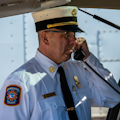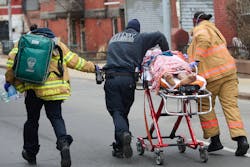Command & Control Success: Below 2,000: Saving Lives, Civilian Lives
The top priority of the fire service is and always should be saving lives. That’s our foundational mission statement regardless of fire department size, staffing and call load.
In the world of sports, athletes commit themselves, sometimes for decades, preparing and fine-tuning in hopes of one day making it to the Big Game. If they make it to the Super Bowl, the World Series, the World Cup, etc., and win, some will retire, because that was what they dreamed of and worked for their entire career/life.
In the fire service, the ultimate win/trophy is searching for and finding someone who is trapped by fire and rescuing that person. A large percentage of members won’t see that day. Very few will pull off a fire service Tom Brady: seven rescues.
As I write this, Brady announced that he will come back for his 23rd season. When you’re dedicated to your craft in the way that Brady is, you have a much higher chance of success, even late into your career. The difference is, success in the fire service is providing another day at life. Don’t be mistaken, the fire service has our Tom Bradys—people such as Capt. Paddy Brown (FDNY) and numerous others who prepared and put themselves in a position to win decade after decade. It can be done and has been done.
We all should be mentally, physically and emotionally prepared. We all should be committed to putting in the daily repetitions, so we have the answers on the day of our biggest test. Remember, everyone has the answers until it’s time to take the test.
Firefighting is more than winning a game or taking a written test and/or getting a trophy. It’s about saving lives and living a career that leaves little regret that you failed to prepare for someone’s worst day.
Aggressive search tactics
All firefighters should work to minimize self-inflicted guilt that results from a lack of commitment to a career of always preparing. Preparation can’t start the day before a big fire or incident where civilian lives will be determined based on the service delivery that’s provided by firefighters. People literally live or die based on firefighters’ abilities and mental focus on searching all areas possible.
We must locate and remove all occupants to the outside environment, where a better medical evaluation of survivability is possible. It’s very difficult in today’s fire environment and/or with lack of visibility to evaluate whether someone can be revived. Fire gloves and the other PPE add to the difficulty. I have been to numerous fires where people who were seriously burned and were found unconscious were revived in the front yard, in the back of an ambulance or at the hospital.
The fire at a 19-story apartment building in the Bronx on Jan. 9, 2022, which came in at 10:55 a.m., claimed the life of 17 people. This was the deadliest fire in New York since March 25, 1990, which was an arson fire at the Happy Land social club that claimed 87 lives. Another deadly fire in the Bronx on Dec. 28, 2017, claimed the life of 13 people and injured 14 others, some of whom had to be resuscitated. Although we frequently read the number of deaths that occurred at fires, we rarely see the number of people who were saved by firefighters.
It’s time that all fire departments in America and around the world make rapid location, removal and treatment of victims through aggressive search tactics top priority at fires. Departments, including those that are in rural and suburban America, must initiate targeted searches immediately to include VES, which allows for more successful searches through the traditional search tactics that utilize the primary entry point. The result will be that victims will be located and removed faster, and medical intervention will start earlier.
Firefighter Rescue Survey
We now have more than 2,500 Firefighter Rescue Surveys completed. They provide the most accurate street-level data to drive search training and regarding where searches should be targeted. Before 2016, we relied on shared individual experiences and information in articles and chapters in books. These experiences are good, but they are limited to an individual’s experiences from a few grabs. The great detail of a collected experience of more than 2,500 firefighter rescues of civilians who were trapped by fire covers more than just where the civilians were located; it covers time of day, who found the civilian(s) and the tactical function of the firefighter(s) who located the civilian(s).
In just the first 10 weeks of 2022, the Firefighter Rescue Survey came across 234 new reports of U.S. fire incidents that had civilian rescues by firefighters. The Firefighter Rescue Survey collected detailed information on 89 of these incidents. From those reports, the survival rate for civilians who were rescued by firefighters was 70 percent. This is consistent with the data from the first 2,500 rescues that were reported through the Firefighter Rescue Survey. Yes, seven out of 10 of the civilians who we go in and get survive.
Every day, U.S. firefighters respond to fires that have victims trapped, and firefighters are locating, removing and frequently having a successful return of circulation. More and more departments utilize Cyanokits to increase the odds of survival. Where once civilians died from products of combustion and a delay in being found by firefighters because culture didn’t push search as a priority, they now are being located and removed, and they survive.
My experience in northwest Florida has been that many of the civilians who were rescued from fire in the past 10 years wouldn’t have survived if not for the cultural shift that happened in our region. It appears that success builds on success, even with rescues.
Returning to Brady, once you realize that you can win, you want to win even more, and this mindset is so important for the thousands of Americans each year who are trapped by fire.
New priority
The days of stretching a line and assuming that fire attack alone will save whoever and whatever can be saved are done. Yes, water creates and maintains survivable space within a structure, but it won’t remove anyone from the fire environment. Stopping fire growth and the products of combustion is a huge priority and does save thousands of lives each year. However, when smoke detectors fail and just extinguishing a fire fails to save everyone, you must rely on aggressive search and removal tactics. Because when all of those things fail, we can’t fail. It’s our duty to give 100 percent to those who still are trapped by fire so that they can be afforded that 70 percent chance of survival.
We have come a long way since 1973, when the National Commission on Fire Prevention and Control completed its landmark report on the nation’s fire problem, “America Burning.” We’ve come a long way from reducing annual civilian fire fatalities to fewer than 3,000 from 12,000. Unfortunately, the data show that we now are in a plateau. We must increase our rescue abilities. Again, when fire prevention fails to prevent the fire—and smoke detectors fail to notify occupants to get out—it’s critical that we must not fail!
The fire service collectively must evaluate response models, current fire behavior, UL studies and newer building construction, to include the average size of houses that are built today. The priority for response models should be getting enough firefighters on the residential fireground to not only get water on the fire but also conduct a rapid and thorough search. The numbers from the Firefighter Rescue Surveys that were completed since 2016 show us that we must locate and remove trapped occupants in no longer than 8 minutes. The survival rate is roughly 70 percent if occupants are rescued in that time frame. The surveys also show that firefighters who conduct searches simultaneous to but separate from fire attack have the greatest success. The primary search team found the victim(s) 58 percent of the time; the attack team only 25 percent of the time.
If we can build a response model that gets enough firefighters to attack the fire and enough to search at the same time, we could add these numbers together and get to 83 percent. Larger urban departments historically have sent an engine company and a ladder company directly to the scene of a fire to do this exact thing. So, now is the time for smaller departments in suburban and even rural America to adjust their response model to get the first and second fire company to the scene, to have enough firefighters to use tank water and start a fast attack and a rapid search. The search should be thought out strategically based on numerous factors but definitely the data from the Firefighter Rescue Surveys.
Our training must be more than just the first floor VES drill, rescuing a homemade baby that weighs 5 lbs. We must incorporate second, third and fourth floor drills that utilize larger manikins and even live victims.
Suburban departments that respond with minimal ladder companies should evaluate based on district whether carrying something that’s larger than a 24-foot ground ladder might be a better option.
The Year of the Rescue
As I complete this column, a 15-month-old male was rescued on March 15, 2022, at 10:52 a.m. from a single-wide mobile home in Navarre, FL. The 15-month-old has more than 30 percent burns but is alive based on an aggressive culture of People Before Water. The Holley-Navarre Fire District, which was involved in the rescue, trained literally the day before on booster back-up and VES tactics to maximize the first and second companies working together to get water on the fire without delaying search operations.
Together, we can make 2022 the Year of the Rescue and get below 2,000 civilian fire fatalities through aggressive rescue operations on the fireground.
About the Author

Curt Isakson
Curt “Ike” Isakson is a 30-plus-year veteran of the fire service. He worked for Escambia County, FL, Fire Rescue for 25 years. Isakson previously worked nine years for the Pensacola, FL, Fire Department, where he was assigned as a company officer on Heavy Rescue 31. His fire service experience started at a young age as a junior firefighter with the Midway, FL, Fire District; he rose through the ranks to captain. Isakson's identification of the need for a series of special-interest fire conferences spawned the development of County Fire Tactics, which covers officer development, command officers, water on fire, high-rise operations, and leadership and tactics.

